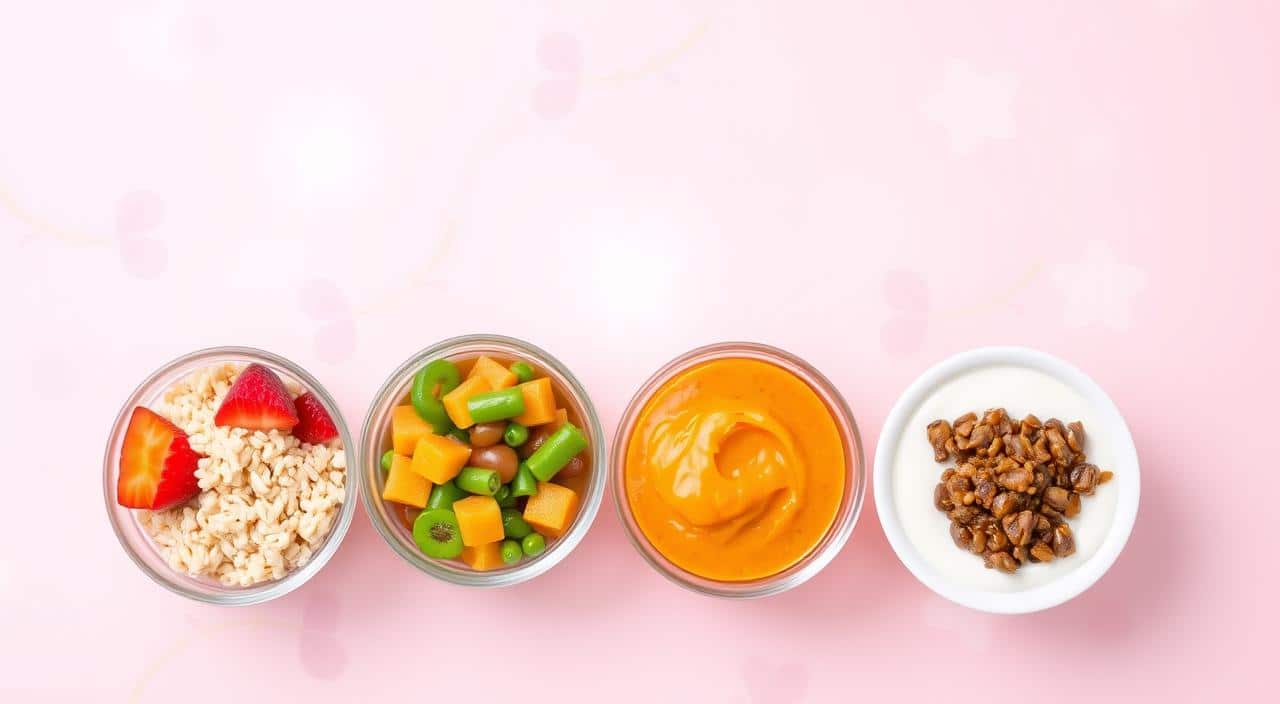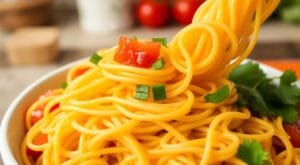Jump to:
Estimated reading time: 12 minutes
Table of contents
What are the 5 types of baby food? when your baby is 4 to 6 months old, it’s time to introduce solid foods. This lets them discover new tastes and textures. The American Academy of Pediatrics (AAP) suggests starting solids around 6 months. But, it’s important to watch your baby for readiness signs.
Some babies might be ready sooner, while others might take longer. Never start solids before 4 months. Look for signs like sitting up, holding their head, and showing interest in food.
What are the 5 types of baby food? Key Takeaways
- The American Academy of Pediatrics recommends introducing solid foods around 6 months of age.
- Babies should show signs of developmental readiness, such as sitting up, controlling head and neck, and opening their mouth for food.
- There are 5 main types of baby food: purees, cereals, finger foods, dairy/dairy alternatives, and protein-rich foods.
- Introducing a variety of nutrient-dense foods helps establish healthy eating habits and supports proper growth.
- Homemade and store-bought baby foods both have pros and cons to consider when feeding your little one.
What are the 5 types of baby food? Introduction
As your baby grows, it’s time to start them on solid foods. This is a big step, but it’s not about getting all their nutrients from food yet. They’ll still get most of their calories and nutrients from breast milk or formula.
When your baby is ready, usually between 6 and 9 months, you can start a meal routine. This includes breakfast, lunch, and dinner. It’s a fun time to watch them learn to eat.
The American Academy of Pediatrics (AAP) says to start solids around 6 months. But, some babies might be ready earlier, at 4 months. Make sure your baby can sit up, has good head control, and is curious about food before starting.
Introducing solids too early can cause problems like tummy issues and allergies. It’s better to wait until they’re really ready.
Exploring the world of baby food stages is exciting. It’s key to know the different types of baby food and how to introduce them safely. This guide will help you choose the best foods for your baby.

Every baby is different, and when they’re ready for solids can vary. Be patient and watch for signs that your baby is ready. This is a new and exciting part of their life.
What are the 5 types of baby food? 1. Purees: The First Stage of Baby Food
As your baby starts their food journey, smooth and creamy purees are often the first step. These meals are full of nutrients and help babies get used to new tastes and textures. They also help babies learn to control their tongue and find out if they have any food allergies.
Signs that show your baby is ready for purees include sitting up on their own, controlling their head, neck, and body, showing interest in food, and trying to put things in their mouth.
Single-Ingredient Purees: Sweet Potatoes, Carrots, and Peas
The American Academy of Pediatrics (AAP) says to start with single-ingredient purees. This helps you see if your baby has any allergies and gets used to different tastes. Sweet potatoes, carrots, and peas are good choices because they are full of vitamins and minerals.
Blended Purees: Apple and Pear, Banana and Avocado
When your baby gets used to single-ingredient purees, you can try blended ones. Mixtures like apple and pear or banana and avocado add variety and new textures. Avocados are full of healthy fats, and bananas are sweet and have B vitamins.
Store-Bought vs. Homemade Purees: Pros and Cons
Parents often wonder if to buy or make baby food. Store-bought purees for infants are easy and safe. But making homemade baby food recipes lets you control what goes in and can make allergen-free baby foods. It’s about what you prefer and what you have time for, but both can be good for your baby.

“The first year of a baby’s life is a crucial time for developing healthy eating habits and food preferences. By introducing a variety of nutrient-rich purees, you’re laying the foundation for a lifetime of balanced and adventurous eating.”
What are the 5 types of baby food? 2. Baby Cereals: Rich in Iron and Nutrients
Baby cereals with iron are a great first food for your baby. Iron is key for your baby’s growth, as their iron stores from pregnancy start to run low by 6 months. These cereals are packed with nutrients to help your child grow strong.
Types of Baby Cereals: Rice, Oatmeal, and Multigrain
There are three main types of iron-fortified baby cereals: rice, oatmeal, and multigrain. These cereals are a great start for your baby’s solid food journey. They offer a lot of iron and important vitamins and minerals.
How to Prepare and Serve Baby Cereal
To make baby cereal, mix 1 teaspoon of single-grain cereal with 4 to 5 teaspoons of breast milk or formula. As your baby gets better at eating, you can make the cereal thicker. The American Academy of Pediatrics warns against mixing cereal with your baby’s bottle to avoid choking.
Adding Fruits or Vegetables for Extra Flavor and Nutrition
When your baby gets the hang of cereal, you can add fruit or veggie purees. This makes meals more interesting and adds more nutrients like vitamins and minerals.
“Introducing a variety of baby food types, including iron-rich cereals, supports proper growth and nutritional balance for your little one.”
What are the 5 types of baby food? 3. Finger Foods: Encouraging Self-Feeding
As your little one grows, it’s time to move from smooth purees to finger foods. This stage, called baby-led weaning, helps them become independent. It also supports their overall growth.
Safe Finger Foods for Babies
Give your baby soft, easy-to-grasp foods like:
- Soft, ripe fruits like banana, avocado, and cooked pear
- Steamed and mashed vegetables like sweet potato, broccoli, and carrots
- Small pieces of cooked pasta or soft, gentle pasta shapes
Stay away from hard, raw foods that could be choking hazards. Always watch your baby while they eat.
Transitioning from Purees to Finger Foods
When your baby is about 7-8 months old, start with allergen-free baby foods and nutrient-dense baby meals in finger food form. This slow introduction helps them get used to different textures and improves their chewing.
Monitoring for Choking Hazards and Encouraging Proper Chewing
Watch your baby closely while they eat to make sure they chew right. Give them foods that are the right size and soft. Teach them to take small bites and chew well.
“Introducing a variety of tastes and textures to babies might result in them being less picky later on.”
By using the baby-led weaning method and offering a variety of safe, nutrient-dense baby meals, you help your child learn to feed themselves. This builds a good relationship with food from the start.
What are the 5 types of baby food? 4. Dairy and Dairy Alternatives: A Source of Calcium and Protein
Starting solid foods is a fun time for parents and babies. Human milk or formula should still be the main drink until they are one. But, you can introduce yogurt and cheese early. These foods are full of calcium and protein, helping your baby grow.
Introducing Yogurt and Cheese to Your Baby
Babies can try pasteurized full-fat cheese like mild cheddar and cottage cheese at 6 months. Choose unsweetened and full-fat dairy for more nutrients. Cheeses like brie and stilton are good choices because they have lots of fat.
Choosing Unsweetened and Full-Fat Dairy Options
High-fat dairy has more than 17.5g of fat per 100g. Full-fat dairy is best for babies and young kids until they are 2. It has more nutrients than low-fat options.
Dairy-Free Alternatives: Almond Milk, Coconut Yogurt, and More
If your baby can’t have dairy, there are many other options. Soy, oat, and almond milks are good choices. Make sure to pick unsweetened and fortified ones for the most nutrients.
“Consuming too much cow’s milk can impact the body’s ability to absorb iron, so it’s important to find a balance and offer a variety of nutrient-dense baby meals.”
What are the 5 types of baby food? 5. Protein-Rich Foods: Supporting Growth and Development
As your baby grows, it’s key to introduce many protein-rich foods. Protein helps build and repair tissues, and keeps muscles and bones strong. Give your baby a variety of solid foods for babies like meat, poultry, fish, lentils, beans, and tofu. This ensures they get the nutrient-dense baby meals they need.
Meat and Poultry Options: Chicken, Beef, and Turkey
Ground beef, chicken, and turkey are great protein sources for babies. Make sure to remove fat, skin, and bones before cooking. Cut the meat into small, soft pieces to avoid choking. Beef is packed with iron, zinc, and protein. Poultry offers B vitamins, zinc, and iron.
Plant-Based Proteins: Lentils, Beans, and Tofu
- Lentils and beans are full of protein, fiber, and B vitamins, making them a great choice for babies.
- Tofu is a versatile, protein-rich food that can be mashed, puréed, or diced into small, soft pieces for your little one.
How to Cook and Serve Protein Foods Safely to Babies
Always cook protein-rich foods thoroughly and make them soft and easy to digest. Make sure all foods are the right size and texture for your baby’s age.
| Food | Protein Content |
|---|---|
| Salmon (2 tbsp) | 5.6 g |
| Ground Beef (2 tbsp) | 5.5 g |
| Peanut Butter (1 tbsp) | 3.5 g |
| Eggs (2 tbsp) | 2.7 g |
| Tofu (1 serving) | 1.8 g |
| Cottage Cheese (2 tbsp) | 1.6 g |
| Greek Yogurt (2 tbsp) | 1.4 g |
| Lentils (2 tbsp) | 1.1 g |
| Quinoa (2 tbsp) | 0.5 g |
By offering a variety of solid foods for babies rich in protein, you support their growth and development. Always prioritize safety when introducing new foods and adjust the texture as needed to prevent choking.
Benefits of Introducing a Variety of Baby Food Types
Introducing your baby to different types of food is great for their growth. It helps them develop healthy eating habits and food preferences. It also ensures they get the nutrients they need and helps them explore new tastes and textures.
Promotes Healthy Eating Habits and Food Preferences
Starting your baby on a variety of flavors, textures, and food types early can help them enjoy trying new foods later. Research shows that breastfeeding and trying many foods during weaning makes babies more open to new foods. This openness can last for months.
Supports Proper Growth and Nutritional Balance
Offering a mix of foods ensures your baby gets all the vitamins, minerals, and macronutrients they need. This includes foods rich in protein, iron, and a variety of fruits and vegetables. These foods meet their changing nutritional needs.
Helps with Sensory Development and Food Exploration
Trying different textures, flavors, and smells through varied foods stimulates your baby’s senses. It encourages them to explore food. This helps them develop their taste preferences and chewing abilities, preparing them for a lifetime of enjoying many foods.
“Introducing a variety of baby food types, from purees to finger foods, helps your little one develop healthy eating habits and food preferences, supporting proper growth and nutritional balance, and aiding in sensory development and food exploration.”
| Benefits of Introducing a Variety of Baby Food Types | Key Insights |
|---|---|
| Promotes Healthy Eating Habits and Food Preferences |
|
| Supports Proper Growth and Nutritional Balance |
|
| Helps with Sensory Development and Food Exploration |
|
Frequently Asked Questions.
What are the 5 essential food types for babies?
The five essential food types for babies include fruits, vegetables, grains, proteins, and dairy (or dairy alternatives). Together, these groups provide the necessary nutrients for a baby’s growth and development.
Why are fruits and vegetables important for babies?
Fruits and vegetables are rich in essential vitamins, minerals, and fiber. They help support immune health, digestion, and overall development. Babies often enjoy sweet fruits like apples, pears, and bananas, and mild vegetables like carrots and sweet potatoes.
How can I include grains in my baby’s diet?
Grains like rice cereal, oatmeal, and soft-cooked pasta provide energy and are easy for babies to digest. Start with iron-fortified cereals, then gradually introduce whole grains as your baby grows.
What are good sources of protein for babies?
Protein sources for babies include pureed meats like chicken, turkey, and beef, as well as beans, lentils, and soft tofu. Protein is crucial for muscle development and growth.
Are dairy products safe for babies?
Dairy, like full-fat yogurt and cheese, can be introduced around 6 months in small amounts. Dairy provides calcium and healthy fats, important for bone growth and brain development. Avoid cow’s milk as a main drink until age one
Conclusion
Introducing your baby to different types of food is a big step. It’s the start of a lifelong journey of healthy eating. By offering a variety of tastes, textures, and nutrients, you help your child grow and develop.
As you explore the different stages of baby food, be patient and listen to your baby. Enjoy this time together in the kitchen. Whether you make your own food or buy organic, focus on nutrition and variety.
Learning how to introduce solids and using baby-led weaning can open up a world of safe and nutritious foods. Trust yourself and watch your baby’s love for food grow. It’s a fun and rewarding journey.






